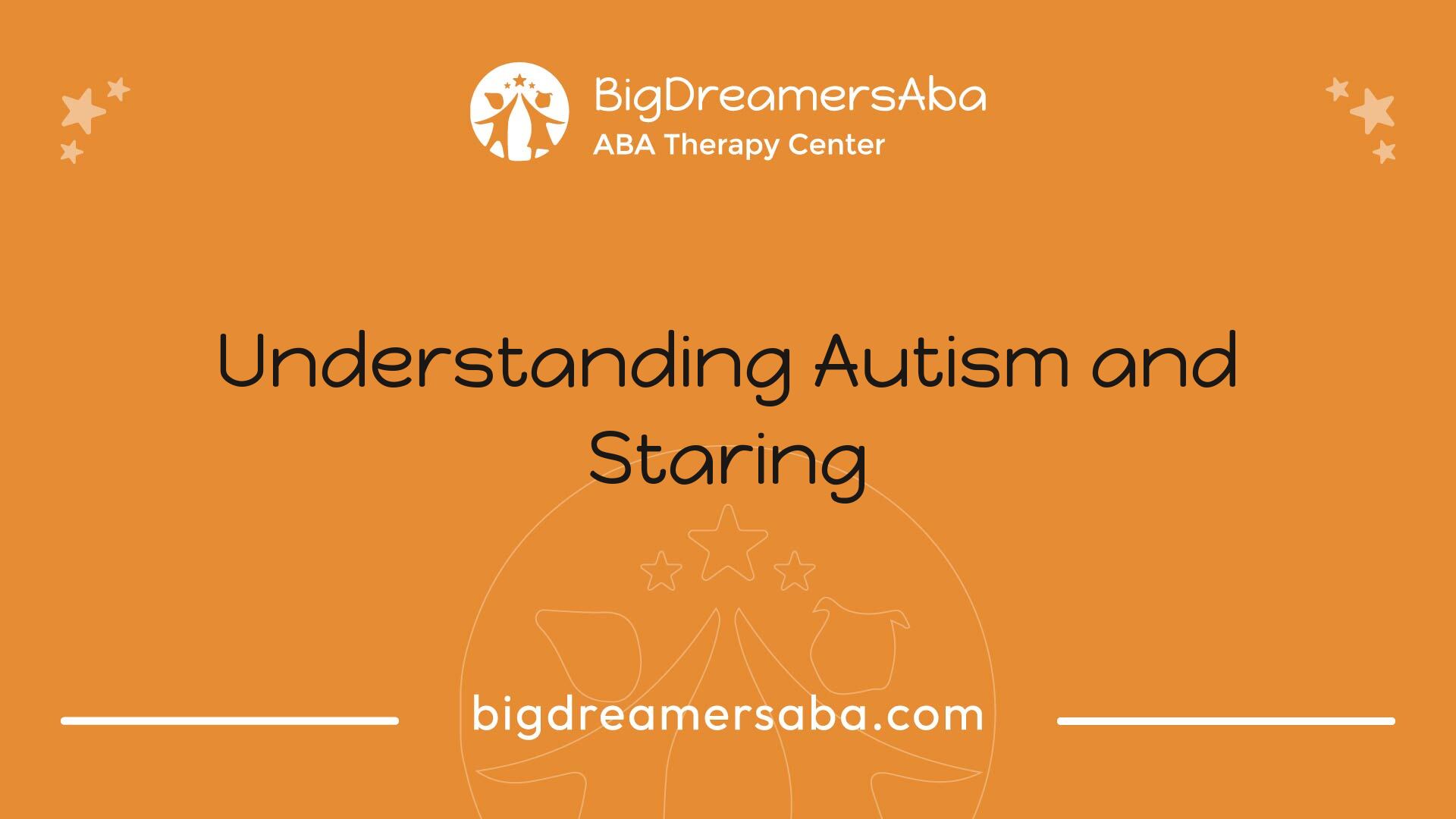Intense Stare in Autism Demystified
Discover the intense stare in autism, its causes, social implications, and communication strategies for understanding.

Understanding Autism and Staring

Prevalence of Autism
Autism, formally referred to as Autism Spectrum Disorder (ASD), is a neurodevelopmental disorder that affects many individuals. According to the Centers for Disease Control and Prevention (CDC), approximately 1 in 54 children in the United States are diagnosed with autism. In the UK, the prevalence rate stands at about 1 in 100 individuals [1].
RegionPrevalence RateUnited States1 in 54United Kingdom1 in 100
Behavioral Characteristics of Autism
Individuals with autism exhibit various behavioral characteristics that can affect their interactions and methods of communication. These may include:
Research indicates that individuals with autism demonstrate different neural responses during gaze behavior compared to individuals who are typically developing [2]. This can result in feelings of hyperarousal during eye contact, leading to avoidance or limited engagement. Such difficulties may also persist and affect social and occupational success throughout life.
Understanding these behavioral characteristics is essential for fostering effective communication with individuals on the autism spectrum. Focusing on nonverbal cues and alternative communication strategies can significantly enhance interactions. Individuals often express unique forms of communication that go beyond conventional methods, emphasizing the importance of awareness and understanding of their experiences. For further insights, visit our section on autism and staring.
Exploring the Intense Stare

Understanding the intense stare often observed in individuals with autism is essential for fostering inclusive interactions. This behavior, while unique, carries significant implications for social communication.
Definition and Description
The intense stare in autism refers to prolonged periods of focused visual attention on a specific object or person. This behavior is characterized by a fixed gaze with limited eye movement or shifts in focus. It can occur in various situations, such as during social interactions or while engaging with the environment [1]. Unlike typical eye contact observed in neurotypical individuals, the intense stare may reflect how an autistic individual processes visual information.
CharacteristicsDescriptionDurationProlonged eye contact or gazeMovementLimited movement or shifts in focusContextsSocial situations, observing objects
Theories Behind the Intense Stare
Several theories explain the intense stare as part of the autism spectrum. One significant factor is sensory sensitivities. Many individuals with autism experience sensory overload that influences their gaze behaviors, including their tendency to fixate on certain stimuli. This can lead to challenges in making eye contact and interpreting social cues [5].
Additionally, research indicates that reciprocal eye contact can be distressing for some individuals on the autism spectrum. Viewing eye contact as a form of hyperarousal, autistic individuals may find this experience uncomfortable. Studies reveal that the amygdala, a brain region involved in emotion processing, exhibits heightened activity in those with autism when looking at eyes, which may contribute to discomfort [3].
Understanding these underlying factors is crucial for addressing misconceptions about the intense stare and enhancing communication strategies. For more insights into visual behaviors related to autism, explore our articles on what is visual stimming?, examples of visual stimming, and whether is staring a sign of autism?.
Social Implications of Intense Staring

Challenges in Social Interactions
Individuals with autism often face unique obstacles in social situations. One significant challenge is the intense stare frequently observed in autistic individuals, which can be misconstrued as unusual or unsettling by people who are neurotypical. This behavior can lead to misunderstandings, as the gaze may be perceived as disinterest or a lack of engagement, even though it might stem from sensory sensitivities or difficulties in processing social cues [5].
Autistic individuals may struggle to understand and interpret social cues, which complicates their ability to build and maintain relationships. The act of making eye contact can trigger adverse emotional and physiological responses, such as feelings of invasion or sensory overload. The resulting difficulties in social interactions can lead to feelings of isolation or exclusion in various social settings.
Social Interaction ChallengesDescriptionMisunderstandingsGaze perceived as disinterestSensory OverloadDifficulty processing visual informationBuilding RelationshipsStruggles in interpreting nonverbal cues
Misconceptions and Awareness
There are numerous misconceptions surrounding the intense stare in autism that must be addressed to foster a more inclusive environment. Many people associate eye contact with social engagement and interest. However, for individuals on the autism spectrum, maintaining eye contact may be challenging due to sensory overload and difficulties in processing social nuances.
Increasing public awareness about the reasons behind the intense stare can help reduce stigma and promote understanding. Adequate knowledge about the challenges faced by individuals with autism can facilitate better communication and interactions. Awareness campaigns and educational resources can be beneficial in dispelling myths, leading to more supportive environments for people with autism.
Common MisconceptionsRealityStaring indicates disinterestIt may stem from sensory sensitivitiesLack of eye contact means avoidanceIt can be linked to processing difficultiesAutistic individuals do not wish to engageMany desire connection but struggle with conventions
Promoting awareness and understanding can help bridge the gap between neurotypical and autistic individuals, creating an environment where understanding replaces misunderstanding. For more information about the interactions between autism and gaze behavior, refer to our article on autism and staring.
Factors Influencing Staring Behavior

Understanding the various factors that contribute to the intense stare often observed in individuals with autism is essential. Two significant influences on this behavior are sensory sensitivities and social anxiety.
Sensory Sensitivities
Individuals with autism frequently experience sensory processing differences that affect their gaze behaviors, including the intense stare. This sensitivity can lead to intense focus on specific stimuli in their environment. Often, the behaviors can serve as a coping mechanism to manage overwhelming sensory input.
Sensory Sensitivity ImpactDescriptionOverwhelming stimuliIncreased stimuli can lead to difficulty in making eye contact and interpreting social cues.Regulating sensory inputStaring may help calm or focus the individual amid sensory overload.Intense interestAutistic individuals may focus intently on objects or situations that captivate them.
For more information about the relationship between sensory processing and visual attention, explore our article on what is visual stimming?.
Social Anxiety and Reciprocity
Social anxiety frequently affects people on the autism spectrum, complicating their interactions and the ability to maintain eye contact. This anxiety can result in adverse emotional and physiological responses when making eye contact, leading to discomfort in social situations. Individuals may feel a sense of invasion or struggle to grasp social nuances, which can further hinder their ability to engage in reciprocal social interactions.
Social Anxiety ImpactDescriptionDifficulty with eye contactStruggles arise due to increased anxiety in social settings.Misinterpretation of cuesDifficulty in understanding nonverbal communication enhances anxiety and reduces engagement.Emotional reactionsNegative emotions tied to social interaction can cause withdrawal or increase staring behavior due to pressure.
For a deeper understanding of how anxiety interacts with visual behavior, see is staring a sign of autism?.
Overall, these factors significantly influence the intense stare observed in autism, shaping both the individual’s interactions and their coping mechanisms during various social situations.
Communication Strategies
Effective communication is essential in fostering social interactions, especially for individuals on the autism spectrum. This section explores alternative communication methods and highlights the importance of nonverbal cues in aiding understanding and expression.
Alternative Communication Methods
Individuals with autism may experience challenges related to traditional verbal communication. To address these difficulties, various alternative communication methods can be utilized. These methods may include:
Supporting nonverbal communication in individuals with autism can involve employing patience and understanding to bridge communication gaps. Allowing extra processing time for responses is also crucial, as it helps create a more inclusive environment.
Importance of Nonverbal Cues
While eye contact is often emphasized in social interactions, many individuals with autism may avoid it or struggle to maintain it due to sensory sensitivities and social anxiety. Understanding that nonverbal communication encompasses a wider array of cues is essential [4]. Recognizing and focusing on other nonverbal signals can foster more effective communication and socially engage individuals with autism.
Some important nonverbal cues include:
Nonverbal CueDescriptionFacial ExpressionsSmiles, frowns, and other expressions convey feelings and reactions.Body LanguagePosture and gestures can indicate openness, confusion, or discomfort.ProximityThe physical space between people can influence comfort levels during interactions.
Creating a sensory-friendly environment can also positively impact gaze behavior, allowing individuals to engage more freely without feeling overwhelmed [2]. By fostering an understanding of alternative forms of communication and nonverbal cues, it becomes possible to enhance social interactions for individuals on the autism spectrum, breaking down barriers to effective communication. For further exploration, you can learn more about visual stimming and its connection to communication.
Diagnostic Evaluation for Autism
Understanding autism and its behavioral characteristics is essential for appropriate diagnosis and support. The diagnostic evaluation for autism involves various assessment tools and steps to understand an individual’s unique needs.
Assessment Tools
Diagnosing autism requires a comprehensive evaluation conducted by qualified professionals. This process often includes multiple steps and assessments. One commonly used tool is the Autism Diagnostic Observation Schedule, Second Edition (ADOS-2), which is a structured observation assessment. It evaluates social communication, interaction, and restricted and repetitive behaviors associated with autism [1].
Here is a summary of assessment tools used in diagnosing autism:
Assessment ToolPurposeAutism Diagnostic Observation Schedule (ADOS-2)Evaluates social communication and interaction patterns.Child Behavior Checklist (CBCL)Measures behavioral and emotional problems in children.Autism Spectrum Rating Scale (ASRS)Screens for symptoms of autism across various domains.Social Responsiveness Scale (SRS)Assesses social awareness and responsiveness.
These assessment tools help professionals gain a clear understanding of the individual's behaviors and challenges.
Diagnosis and Beyond
Once the evaluation is complete, professionals can provide a diagnosis based on standardized criteria. The assessment can reveal essential insights about social interactions, such as difficulties with eye contact. Research from 2022 indicates reduced activity in the dorsal parietal region of the brain during periods of eye contact in individuals with autism. This area is critical for various cognitive functions, including spatial attention and motor planning.
The severity of Autism Spectrum Disorder (ASD) correlates with decreased brain activity during eye contact, suggesting a potential biological marker that can aid in diagnosing and understanding autism [6].
Through a thorough diagnostic evaluation, individuals with autism can receive tailored interventions and support. Understanding their unique characteristics is essential for fostering effective communication and social interaction, especially regarding concepts like autism and staring and is staring a sign of autism?. Such insights can be crucial in developing strategies for support and advocacy in various contexts.
References
[2]:
[3]:
[4]:
[5]:
[6]:
Recent articles

Making Morning Time Stress Free for Kids With ABA Therapy

How ABA Programs Help Kids With Autism Develop Social Understanding
.jpg)